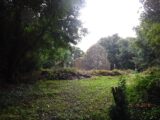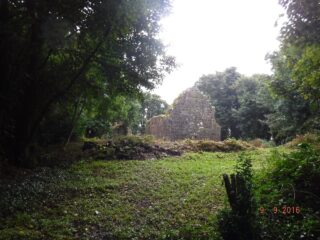Notice
Inchmacnerin Abbey is a National Monument in state guardianship
*No Public Access*
WARNING: It should be noted that these sites are unguided and a level of care and caution should be maintained during all stages of your visit. The Office Of Public Works (OPW) will not be held responsible for any damages, injuries, or losses that occur
Inchmacnerin Augustinian Priory
In the centre of the two-hectare Church Island, to the south-west of Lough Key, is Inchmacnerin abbey. This abbey has been classed as an early ecclesiastical site, but historical references to its foundations and early history is scant. It is known that Inchmacnerin in Irish is Mainistir Inis Mac nÉirín meaning Island of the Sons of Éirín, who adopted the Augustinian rule when St Mary’s was established here between 1140 and 1170. The only other reference is the record of the death of its prior, Muireadach O’Gormley, in 1229.
The church was extended to the east in the 13th century and only the foundations of the ranges around a cloister exist. Originally the buildings were within a rectangular enclosure of drystone walls, with the church completing the enclosure. The original church, 8m north to south and 15m east to west, with a trabeate doorway in the west gable dates to the 10th or 11th century. An inserted doorway in the north wall is identified by the remaining door jambs. The extension to the east measured approximately 30m. Only a section of wall remains of this extension where a single lancet window with external rebate exists.
The saint’s shrine to the north of the church, possibly dedicated to St Columcille, is visible as a masonry structure. It is 4.75m east to west and 2.45m north to south. A round-headed window embrasure was set into the west gable. The original entrance was in the south wall. Excavations took place within this structure in 2002 and 2004 and found the remains of a complete inhumation and the fragments of others. Carbon dating of the burials is between 1021AD to 1216AD. A small stoup, known also as a holy water basin, and a spud stone, which is a stone with a hole to hold a door hinge, were also found. A cairn, north of the saint’s shrine, is believed to have been a well. To the south-west of the church an area of circa 5m by 5m has rows of uninscribed grave-markers, 1m apart, believed to be a cilín, a children’s graveyard.
Visit Historic Environment Viewer for more information on Inchmacnerin Abbey
Protect our Past - Click here to read about the importance of protecting our country’s unique heritage sites
This national monument is protected in accordance with the National Monuments Acts 1930 to 2014
Gallery
Nearby sites to visit
Boyle Cistercian Abbey
Step back into Ireland’s monastic past
Approx. 3.3 km from Inchmacnerin Augustinian Priory
Rathcroghan Visitor Centre
Follow in the footsteps of Queen Medb at Connacht’s ancient capital
Approx. 24.0 km from Inchmacnerin Augustinian Priory
Parke’s Castle
Walk in the footsteps of planters and Gaels
Approx. 30.4 km from Inchmacnerin Augustinian Priory
Carrowmore Megalithic Cemetery
Ireland’s oldest megalithic tombs set in a dramatic neolithic landscape
Approx. 33.1 km from Inchmacnerin Augustinian Priory
Sligo Abbey
Where friars’ prayers echo among the ruins
Approx. 33.6 km from Inchmacnerin Augustinian Priory
Seán Mac Diarmada Cottage
One of the cradles of the Rising
Approx. 39.9 km from Inchmacnerin Augustinian Priory


